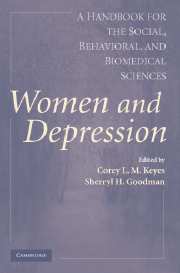Book contents
- Frontmatter
- Contents
- List of Contributors
- Foreword
- Preface
- PART I NOSOLOGY, MEASUREMENT, AND THE EPIDEMIOLOGY OF WOMEN AND DEPRESSION
- PART II BIOLOGICAL, DEVELOPMENTAL, AND AGING MODELS OF RISK
- PART III COGNITIVE, EMOTIONAL, AND INTERPERSONAL MODELS OF RISK
- PART IV SOCIAL, POLITICAL, AND ECONOMIC MODELS OF RISK
- PART V SYSTEMS AND PROCESSES OF TREATMENT, PREVENTION, AND POLICY
- 17 Services and Treatment for Depression
- 18 Prevention of Depression in Women
- 19 Women and Depression
- Author Index
- Subject Index
- References
17 - Services and Treatment for Depression
International Perspectives and Implications for a Gender-Sensitive Approach
Published online by Cambridge University Press: 05 June 2012
- Frontmatter
- Contents
- List of Contributors
- Foreword
- Preface
- PART I NOSOLOGY, MEASUREMENT, AND THE EPIDEMIOLOGY OF WOMEN AND DEPRESSION
- PART II BIOLOGICAL, DEVELOPMENTAL, AND AGING MODELS OF RISK
- PART III COGNITIVE, EMOTIONAL, AND INTERPERSONAL MODELS OF RISK
- PART IV SOCIAL, POLITICAL, AND ECONOMIC MODELS OF RISK
- PART V SYSTEMS AND PROCESSES OF TREATMENT, PREVENTION, AND POLICY
- 17 Services and Treatment for Depression
- 18 Prevention of Depression in Women
- 19 Women and Depression
- Author Index
- Subject Index
- References
Summary
INTRODUCTION
The Global Burden of Disease data for the year 2002 shows that depression is the fourth leading cause of disability in women worldwide and accounts for 5.66% of disability-adjusted life years (DALYs) in women, whereas it is the seventh leading cause of disability in men and accounts for 3.45% of DALYs (World Health Organization [WHO], 2003a). It is projected that by 2020 depression will become the second leading cause of disability in women (Murray & Lopez, 1996). Traditionally, mental health programs have paid little attention to the special or unique needs, of women. But, the heavy burden placed by depression on the mental health of women; the association of depression with different phases of women's life cycle and other gender-specific determinants; and gender differences in clinical presentation, course, response to treatment, service needs, and response of care givers makes a gender-sensitive approach in service development and management of depression an imperative. This chapter includes information from WHO's Project Atlas regarding the availability of treatment services in the world and provides suggestions regarding methods by which the gap between need for and receipt of effective services for depressed women can be reduced. It also reviews the types and efficacy of physical and psychosocial treatment of depression in women and whether such treatments vary by gender. Suggestions from a life cycle perspective on the clinical management of depression in women and issues regarding prevention, disability, and rehabilitation are highlighted.
- Type
- Chapter
- Information
- Women and DepressionA Handbook for the Social, Behavioral, and Biomedical Sciences, pp. 417 - 449Publisher: Cambridge University PressPrint publication year: 2006



